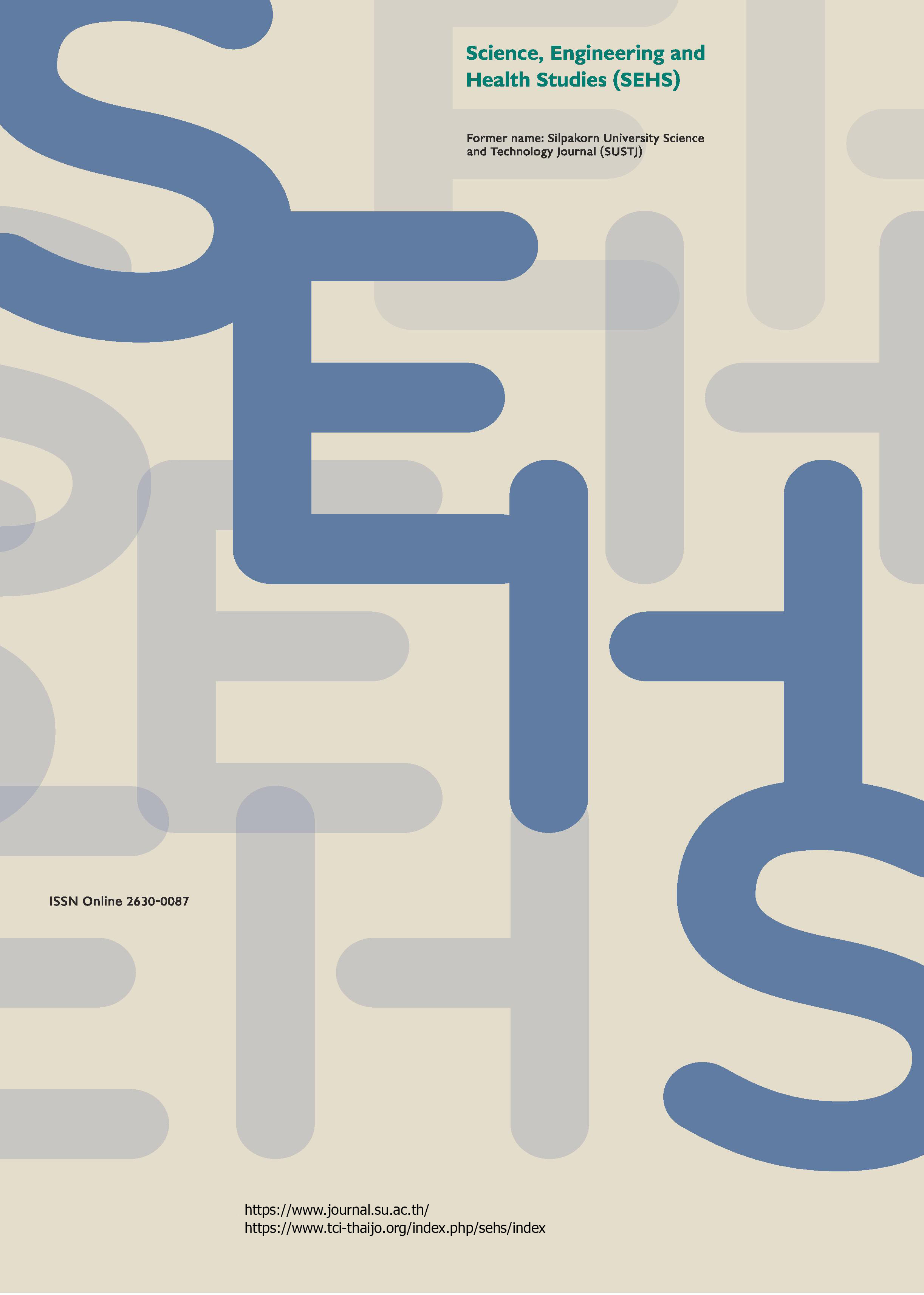Development of empirical models for calculating global and diffuse erythemal weighted solar ultraviolet radiation under clear sky conditions in Thailand
Main Article Content
Abstract
This study introduced semi-empirical models for calculating hourly global and diffuse erythemal weighted ultraviolet (EUV) solar radiation under clear sky conditions in Thailand. To develop these models, global and diffuse erythemal ultraviolet data collected over a decade (2011–2020) from four solar monitoring stations situated in the main regions of Thailand were used. The data was classified into two groups. The first group (2011–2018) was used for modeling, while the second group (2019–2020) was reserved for model validation. The global and diffuse EUV radiation models revolve around semi-empirical functions. These functions express both types of EUV radiation in terms of normalized variables, specifically the total ozone column, aerosol optical depth, and air mass. To assess the accuracy of the proposed models, their outputs for hourly global and diffuse EUV radiation were calculated at the four monitoring stations. These outputs were then compared against actual measurements to validate the effectiveness of the models. The evaluation revealed a root mean square difference of 15.8% for global EUV radiation and 14.9% for diffuse EUV radiation when compared to the mean measured values.
Downloads
Article Details

This work is licensed under a Creative Commons Attribution-NonCommercial-NoDerivatives 4.0 International License.
References
Bilbao, J., Roman, R., Yousif, C., Mateos, D., and de Miguel, A. (2015). UV and global irradiance measurements and analysis during the Marsaxlokk (Malta) campaign. Advances in Science and Research, 12(1), 147–155.
Dombrovsky, L. A., Solovjov, V. P., and Webb, B. W. (2011). Attenuation of solar radiation by a water mist from the ultraviolet to the infrared range. Journal of Quantitative Spectroscopy and Radiative Transfer, 112(7), 1182–1190.
El-Nouby Adam, M., and El Shazly, S. M. (2007). Attenuation of UV-B radiation in the atmosphere: Clouds effect, at Qena (Egypt). Atmospheric Environment, 41(23), 4856–4864.
Grant, R. H., and Gao, W. (2003). Diffuse fraction of UV radiation under partly cloudy skies as defined by the automated surface observation system (ASOS). Journal of Geophysical Research: Atmospheres, 108(D2), 4046.
Gueymard, C. (1993). Critical analysis and performance assessment of clear sky solar irradiance models using theoretical and measured data. Solar Energy, 51(2), 121–138.
Janjai, S., Nuñez, M., Masiri, I., Wattan, R., Buntoung, S., Jantarach, T., and Promsen, W. (2012). Aerosol optical properties at four sites in Thailand. Atmospheric and Climate Sciences, 2(4), 441–453.
Kasten, F. (1965). A new table and approximate formula for relative optical air mass. Archiv für Meteorologie, Geophysik und Bioklimatologie, Serie B, 14(2), 206–223.
Kudish, A., and Evseev, E. G. (2020). An empirical correlation between erythemal UVB and global irradiation developed for a single site and tested at two sites in Israel. Theoretical and Applied Climatology, 142, 237–242.
Lunde, P. J. (1980). Solar Thermal Engineering: Space heating and hot water systems, New York, NY: John Wiley & Sons.
Mateos, D., Bilbao, J., de Miguel, A., and Perez-Burgos, A. (2010). Dependence of ultraviolet (erythemal and total) radiation and CMF values on total and low cloud covers in Central Spain. Atmospheric Research, 98(1), 21–27.
Nunez, M., Kuchinke, C., and Gies, P. (2002). Using broadband erythemal UV instruments to measure relative irradiance. Journal of Geophysical Research: Atmospheres, 107(D24), 4789–4802.
Scaglione, D., Giulietti, D., and Morelli, M. (2016). Evaluation of the impact of atmospheric ozone and aerosols on the horizontal global/diffuse UV index at Livorno (Italy). Journal of Atmospheric and Solar-Terrestrial Physics, 146, 194–204.
Villán, D. M., de Miguel Castrillo, A., and Santos J. B. (2010). Empirical models of UV total radiation and cloud effect study. International Journal of Climatology, 30(9), 1407–1415.
Webb, A., Gröbner, J., and Blumthaler, M. (2006). COST-726: A Practical Guide to Operating Broadband Instruments Measuring Erythemally Weighted Irradiance (No. EUR22595), Luxembourg: Publications Office of the European Union, pp. 1–21.
WHO. (2002). Global Solar UV Index: A Practical Guide (WHO/SDE/OEH/02.2), Geneva: World Health Organization, pp. 1–32.


